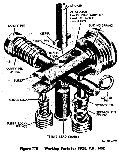Fuze, M52
This article is from TM 9-1904 which is available on this site.
The contents have been supplemented with modern photos and comments or additional information added in some instances.
Date Compiled: 7/17/2007
Editor: Chris Guska
Photos: Drew Ballard
Point-detonating Fuse M52.
Description. The M52 Fuse is a super quick fuse used to effect the functioning of rounds fired from the 81-mm and 60-mm mortars. It is normally used with light shell when fragmentation above the ground is desired. This fuse will fit any of the present. "M" series of shell; however, it is only assembled in the following shell at present:
M43A1 H.E. for M57 Chemical for
81-mm T.M. 81-mm T.M.
M43A1 Practice for M49A2 HE. for
81-mm T.M. 60-mm T.M.
M44 Practice for MSOA2 Practice for
81-mm T.M. 60-mm T.M.The weight of the fuse is 0.45 pound.
The fuse housing is made of aluminum. The head of the fuse screws into the body. The head houses a long protruding striker and a compressed restraining spring. The striker and restraining spring are held in place by a keeper. The body houses the slider, slider lock, safety pin, and set-back pin, with their respective springs. In the center and at the base of the body is an inverted cup known as a lead cup. It is held in place by crimping and contains a tetryl lead pellet. The base of the body is internally threaded to receive a booster cup which in turn houses a tetryl booster pellet. The slider carries a detonator and a blank flash hole to receive and protect the firing pin from shocks dui to handling and set-back action.
Safety features. The safety features correspond to the M45. The M52 Fuse is bore safe. This is accomplished by the assembling of the detonator into a slider which in the unarmed position holds the detonator out of alignment with the firing pin and the tetryl lead charge. Arming of the slider within the bore of the weapon is prevented by the safety pin, the head of which bears against the bore and retains the slider in the unarmed position. To prevent arming of the set-back pin, which holds the safety pin in position, a cotter pin (safety wire in later manufacture) is utilized.
Function. This fuse is armed in the same manner as the M45. The cotter pin or safety wire is removed to free the set-back pin. The shell is dropped down the bore of the weapon. The force of set-back resulting from ignition of the propelling charge causes the set-back pin to move rearward against its spring. This frees the safety pin. The safety pin, due to the action of its spring, is forced out of the fuse until its head comes in contact with the bore of-the mortar. After emerging from the mortar, the safety pin is completely ejected by its spring from the fuse. The slider is now free, and due to the action of the slider spring, is forced into the armed position, thereby bringing the detonator in direct alignment with the explosive train. The slider also serves to close the hole left by the safety pin, so as to prevent the entrance of mud or dirt into the slider cavity which might interfere with the fuse functioning. The slider is locked in the armed position by a slider lock which is forced into a recess in the slider by a slider lock spring.Upon impact with the target, the striker is forced inward against its spring bringing the firing pin into the detonator charge of priming mixture, lead azide, and tetryl. The wave produced functions the lead charge of tetryl which in turn detonates the booster of tetryl. The booster charge amplifies the wave and sends it to the shell filler.
Point-detonating Fuse M52B1. This fuse differs from the M52 in that the body and head housing are made of bakelite instead of aluminum as the M52. In all other respects, it is identical to the M52 Fuse.
Point-detonating Fuse M52B2. This fuse differs from the M52 in that the body housing is made of bakelite, but the head housing is made of aluminum alloy. In all other respects, it is identical to the M52 Fuse.
90th IDPG Weapons




